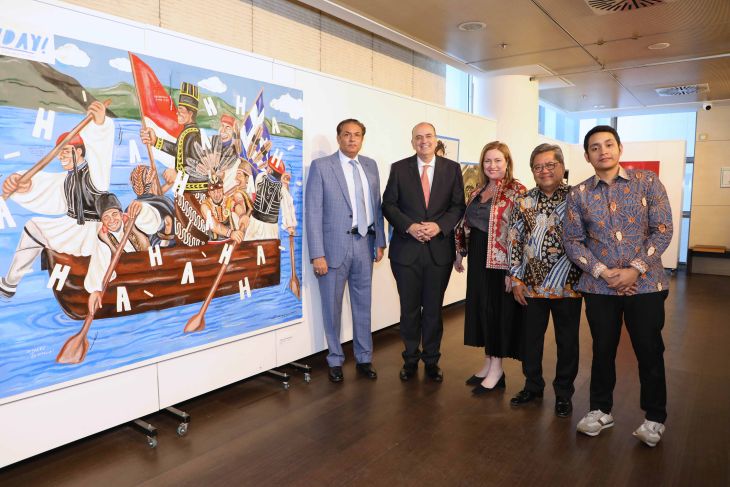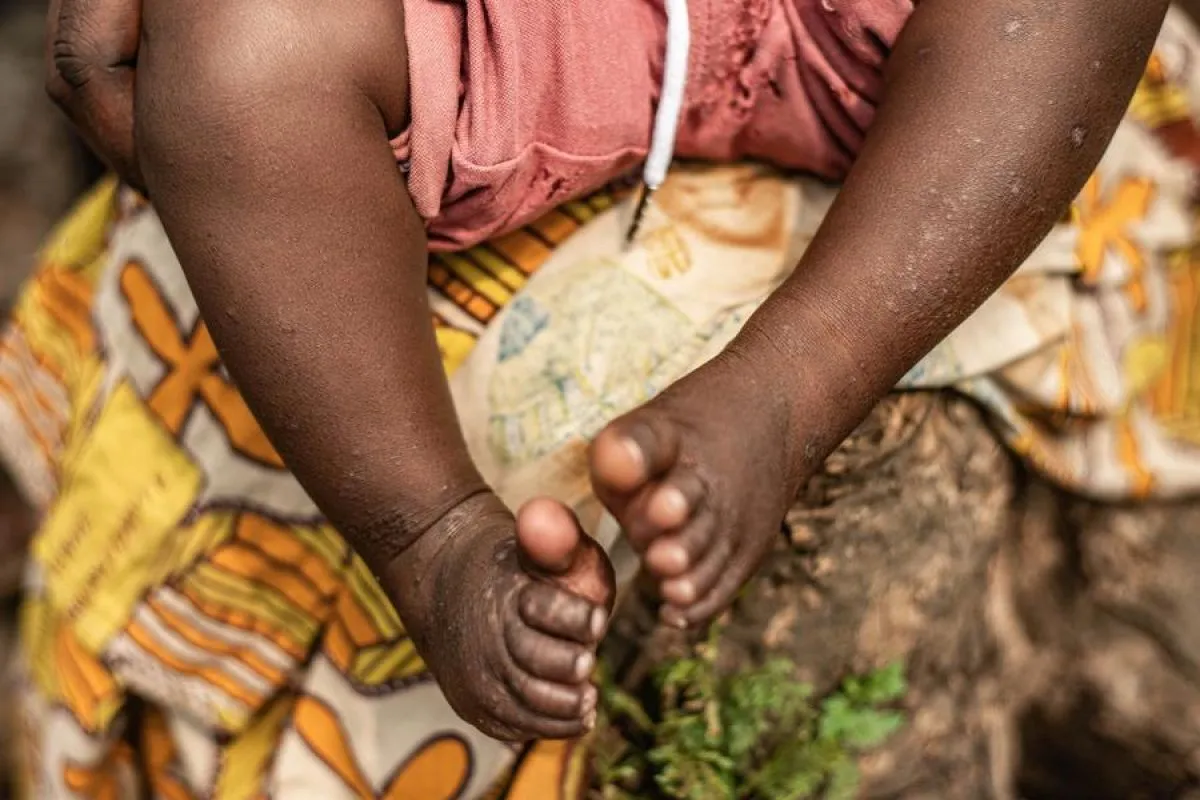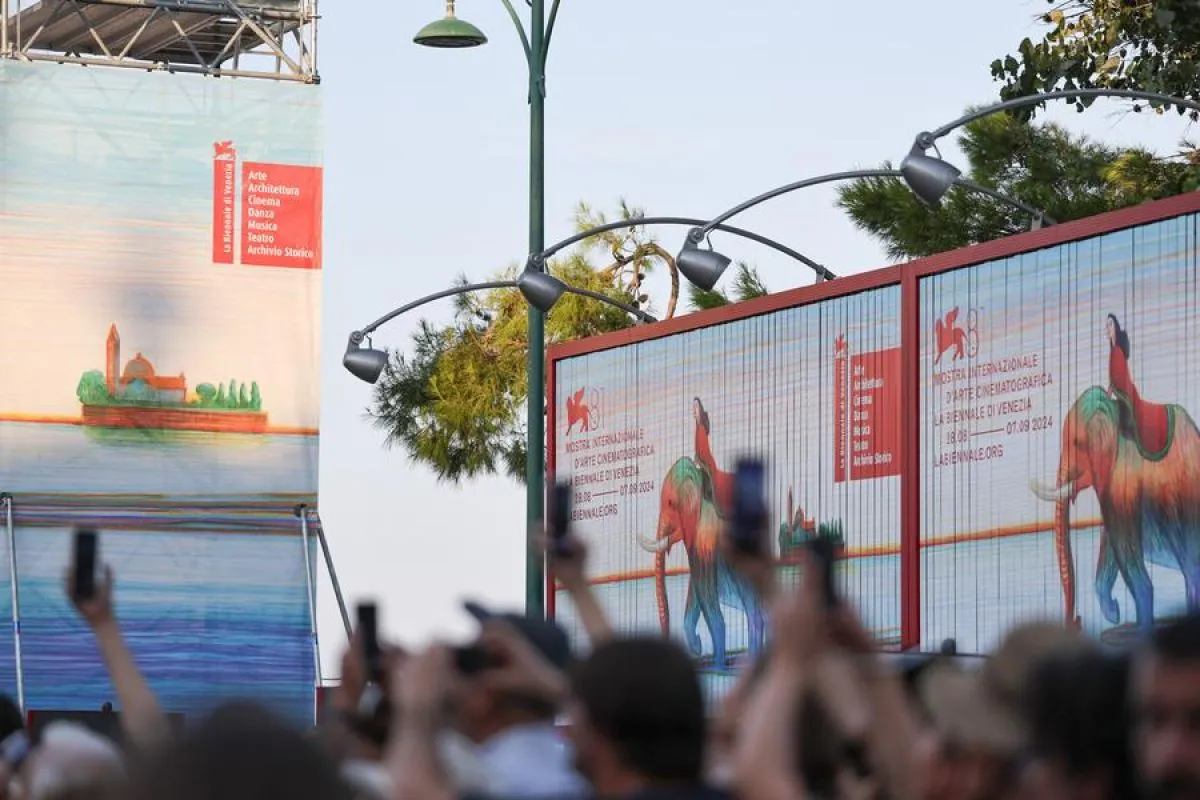Live Streaming
Program Highlight
Company Profile

International News (6884)
October
Celebrating 75 Years of Indonesia-Greece Cultural Ties: A Dynamic Artistic Collaboration
Written by Ofra Regina Suharsil
The exhibition features the olive wood sculptures 'RAMA SINTHA' by Balinese artists I Made Sumantra and I Made Suparta, the marble sculpture 'Antikythera Mechanism' by Greek artist George Kontonikolaou, and collaborative paintings by Indonesian artist Naufal Abshar and Greek artists Caroline de Souza and Pavlina Bechrakis. (ANTARA/HO/Pensosbud of the Embassy of Indonesia in Athens)
October
Minister of Tourism and Creative Economy Sandiaga Uno Promotes Batik at WCCE 2024
Written by Daniel
September
GlobE Network Pledges to Strengthen International Anti-Corruption Cooperation
Written by Ofra Regina Suharsil
Ilsutration of globe around the world (Photo by: pexels.com)
September

September
Scientists Track Plastic Waste in Pristine Canadian Marine Park
Written by Daniel
VOInews, Petit-Saguenay: Piles of old tires, discarded cups, and cigarette butts litter the stunning Saguenay Fjord, a marine conservation area in eastern Canada that attracts belugas and other whales seeking a respite. The fjord, flanked by glacier-carved cliffs, connects to the Saint Lawrence River and is far from any major city. This marine sanctuary has held protected status for 26 years.
"It's one thing to gain protected area status, but how do we maintain it?" asked Canadian biologist Anne-Marie Asselin before diving to search for trash. Along with her team from the Blue Organization, she navigates the brackish waters of the fjord to document pollution in the area.
Their objectives are twofold: to identify the most common types of waste to target plastics that should be banned from sale, and to predict which banks are most at risk of pollution, particularly based on currents, to better target cleanup campaigns.
Using paddleboards, walking, or freediving, Asselin and her team collect various types of waste in the bay of the village of Petit-Saguenay. Under the blazing sun, Laurence Martel from the group sorts the waste by over 100 criteria, including brand, to ultimately hold producers accountable for the entire lifecycle of their products.
"The most common find is the cigarette butt; it is omnipresent," Martel said. She noted that a single cigarette butt can contaminate up to 500 liters of water due to the thousands of chemical compounds it contains.
Over five years, the team's research has revealed a worrying trend: the concentration of plastic waste is significantly increasing closer to the Gulf of Saint Lawrence and the Atlantic, "suggesting a shift in waste from urban areas towards downstream parts of the river," she added. "Very often, the smallest plastics are the ones that pollute the most," Martel stated.
Waste breaks down into microplastics. These particles, often invisible to the naked eye, are made from polymers and other toxic compounds that vary from five millimeters to one thousandth of a millimeter. Microplastics are found throughout the marine food chain, particularly in invertebrates.
The Blue Organization captures and analyzes these "sentinel species," considered indicators of environmental health, during each cleanup operation. "If your mussels and your invertebrates are starting to suffer, that could be an indicator that the health of the ecosystem is also declining," said Miguel Felismino from McGill University in Montreal.
Seated on a catamaran, Felismino measured, photographed, and arranged mussel specimens, which he will also analyze in a laboratory to study the effects of microplastics. Using a homemade pump and a few pipes placed at the front of the boat, he also collected surface water and sediment from the seabed for his research.
The Blue Organization aims to produce a comprehensive picture of the plastic lifecycle in protected areas like the Saguenay-Saint Lawrence Marine Park. However, to protect these ecosystems, the solution is "also to trigger behavioral changes" in people, said biologist Asselin, who has called on artists to "raise awareness" about the situation.
This could involve creating music from natural sounds or producing a "literary translation" of scientific research, Asselin said. "With climate change, the soundscapes associated with certain territories are set to evolve," said one such artist, Emilie Danylewick, before plunging her hydrophone into the water to record the sounds. Danylewick added that her work is a "way to preserve the current soundscape memory of the territory."
Source: AFP
September
September
Britain is back and ‘open for business’, says trade policy minister on boosting economic ties
Written by nuke
British Prime Minister Keir Starmer leaves 10 Downing Street in London, Britain September 4, 2024. Britain, under his new Labour government, is pursuing new trade ties with the rest of the world. (REUTERS/Toby Melville/File Photo) -
VOInews, London : Southeast Asia is among the key engines of global growth in the years to come and poses “a huge commercial market”, said British Trade Policy Minister Douglas Alexander. The region has a population of about 680 million people and an estimated total gross domestic product amounting to approximately US$3.6 trillion.
“There are real opportunities, both for investments into the United Kingdom and exports from the UK to this global growth pool,” said Mr Alexander, who is currently in Laos to attend the Association of Southeast Asian Nations (ASEAN) Economic Ministers’ Meeting.
“We are here with a very straightforward and open message: Britain is back and we're open for business,” he told CNA on Wednesday (Sep 18).
Britain, under the new Labour government, is pursuing new trade ties with the rest of the world. British Prime Minister Keir Starmer has made economic growth the central mission of his administration, and sees giving businesses access to international markets as a key step. Mr Alexander said the UK is taking a “twin-track approach” to trade.
“We are seeking to reset and rebuild our trading relationships with our neighbours and partners in the European Union,” he added.
“At the same time, we're seeking to seize the opportunities of strengthening our trading relationships right around the world.”
The UK has been pursuing a range of free-trade deals since its departure from the EU.
“In every trade deal, there are complexities, there are challenges, there are negotiations that need to be resolved,” Mr Alexander noted.
“But I genuinely believe that liberalising trade and securing effective free trade agreements can be actual win-wins for both of the parties.”
By the end of this year, the UK will join the Comprehensive and Progressive Agreement for Trans-Pacific Partnership (CPTPP), an Asia-Pacific trade bloc.
“That's a market of about 600 million consumers. It includes some of the most dynamic growing economies anywhere on earth,” said Mr Alexander.
“So, that's a good example of the kind of modern trade deal that the UK is looking forward to striking now and in the years ahead.”
Several UK ministers are in the Indo-Pacific region this week for various talks, to show the Labour government’s new approach on the world stage.
“The Indo-Pacific is basically the fastest growing region in the world,” said British Minister for the Indo-Pacific Catherine West on the sidelines of the Milken Institute’s Asia Summit in Singapore.
While there are many opportunities available for its businesses, Britain also has “a lot to offer” the region, including areas such as education, climate change and culture, she told CNA on Wednesday.
“We're open for business,” she said, echoing Mr Alexander.
“We're going to have a sense of predictability, so that people are very clear that they can invest in the UK and we can have investments here in the Indo-Pacific. Together, we can have that prosperity that we all wish to see.”//CNA-VOI
September
Asian share markets mixed after US Fed's bumper interest rate cut
Written by nuke
A passerby walks past an electric monitor displaying various countries' stock price index outside a bank in Tokyo, Japan. (File photo: Reuters/Issei Kato) -
VOInews, Tokyo : There was mixed reaction across Asian share markets on Thursday (Sep 19) after a bumper interest rate cut by the US Federal Reserve. The Fed lowered its window for the benchmark policy rate by 50 basis points to between 4.75 per cent and 5 per cent. In Singapore, the Straits Times Index was up 0.47 per cent as of 10.39am. Japan's Nikkei share average rose more than 2 per cent, led by export-oriented stocks, as the yen weakened against the US dollar despite the Fed interest rate cut.
The Nikkei was up 2.1 per cent at 37,133.34, as of 12.08am GMT, while the broader Topix was up 1.9 per cent to 2,614,09. Uniqlo brand owner Fast Retailing rose to give the biggest boost to the Nikkei. Technology start-up investor SoftBank Group rose 1.4 per cent.
All of the Tokyo Stock Exchange's 33 industry sub-indexes were trading higher, led by the automakers' index, rising 3.9 per cent. Toyota Motor jumped 4.9 per cent. MSCI's broadest index of Asia-Pacific shares outside Japan was down 0.4 per cent in early trade, pressured as South Korean markets returned from holidays with heavy falls in the chipmaking sector following a downbeat Morgan Stanley note. South Korea's Kospi Index was down 0.92 per cent as of 1.56am GMT.
Meanwhile, SK Hynix shares tumbled 9.6 per cent and Samsung fell 2.6 per cent. China shares dipped on Thursday as concerns over a fragile economic recovery offset any benefits seen from the Federal Reserve's overnight decision to cut interest rates. China's blue-chip CSI300 Index and Shanghai Composite Index both slipped 0.5 per cent in early trade, while Hong Kong benchmark Hang Seng was roughly flat.
Investor sentiment towards Chinese equities remained subdued even though the US rate cut provided room for fresh easing by Beijing to support its sputtering economy. Yan Wang, chief emerging markets and China strategist at Alpine Macro, said while Fed rate cuts are generally positive for emerging market assets, China's domestic macroeconomic policies and growth outlook are far more critical than the Fed's actions.
By sector, Hong Kong-listed mainland property stocks outperformed the broader market and was up 2.3 per cent. Tracking the US central bank's move, the Hong Kong Monetary Authority (HKMA) on Thursday cut its base rate charged via the overnight discount window by 50 basis points to 5.25 per cent. Hong Kong's monetary policy moves in lock-step with the United States as the city's currency is pegged to the greenback in a tight range of 7.75 to 7.85 per dollar//CNA-VOI
September
WHO Prequalifies First Mpox Vaccine, Opening New Path for Global Access
Written by Ofra Regina Suharsil
A child infected with mpox is photographed in the Nyiragongo area near Goma, North Kivu province, Democratic Republic of Congo (DRC) August 15, 2024. (Photo by: ANTARA/Xinhua/Zanem Nety Zaidi)
September
Exploring the Future of Film: Venice Immersive Merges Cinema with Virtual Worlds
Written by Ofra Regina Suharsil
People take photos near the Palazzo del Cinema during the 81st Venice Film Festival on Lido Island, Venice, Italy, on August 30, 2024. (Photo by: ANTARA/Xinhua/Li Jing)


